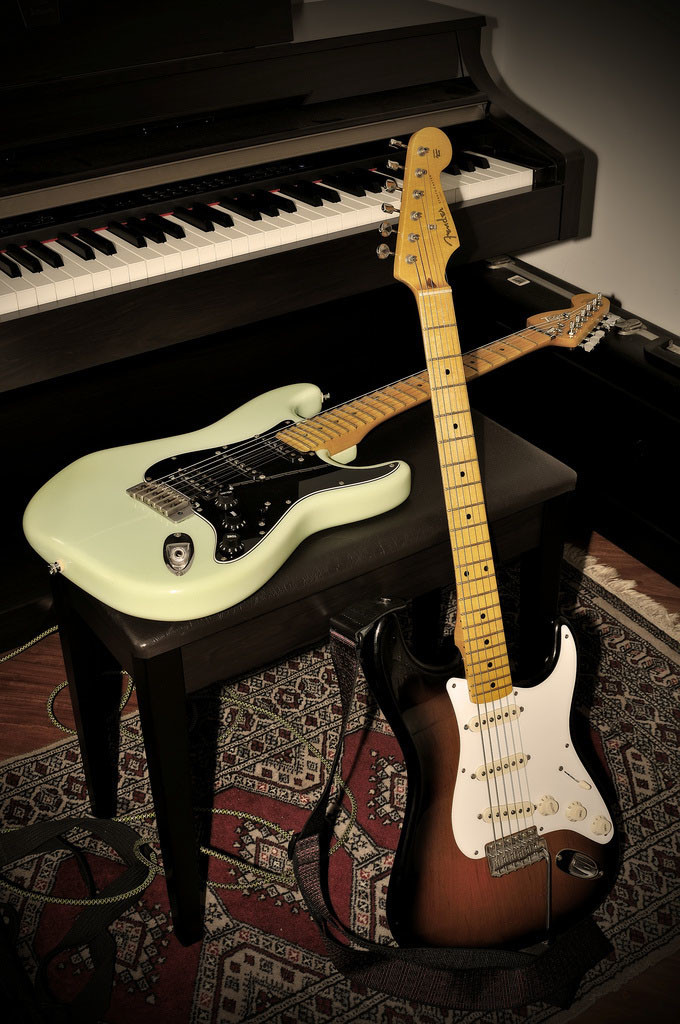
This week I will not write about music theory or technique. I will dedicate some time to talk a bit about the Fender Stratocaster history, since it is one of the most important musical instruments in modern history. You may already have noticed that I am a Strat expert and just love these things. So I thought it was a good idea to share my knowledge and, who knows, gather more Strat adopters.
Fender Stratocaster History — Table of contents
Fender Stratocaster History: the beginning
1954
The Fender Stratocaster history started in 1954, when Leo Fender, George Fullerton and Freddie Tavares designed the double cutaway guitar body that would change the history of music forever. In its experimental phase, from March to September of 1954, the Stratocaster was hand made and its specifications changed a lot, until they settled with the production model released in October.
The first Fender Stratocaster had a single-piece ash body with a two-color sunburst finish; a single-piece maple neck with a thick “U” (also referred as “D”) profile, 7.25” radius fingerboard; 3 hand-wound single coil pickups connected to Stackpole 250k ohms pots and a 3-way switch; Kluson Deluxe (unbranded) tuners and a guitar-shaped case.
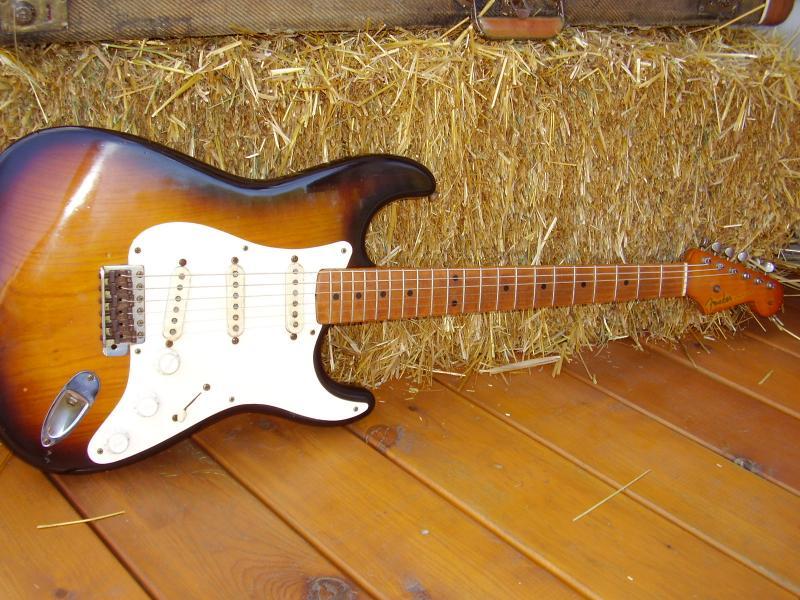
1954 Fender Stratocaster
© Stratospheric2 (as of 2011-09-23)
The 1954 Stratocaster is a very rare instrument and can reach unbelievable prices (I have actually seen on for sale for $95000). I had the opportunity to play this instrument once in my life (and probably will not be able to play it ever again). Despite the very uncomfortable neck and Les Paul-grade weight (yes, it was very heavy), it has the best Strat tone I have ever heard.
1955
The 1955 model had some minor cosmetic changes, but as the production process became more refined, the build quality improved a lot and the instrument was better to play than the 1954 model overall — mostly because it lost a few pounds of weight.
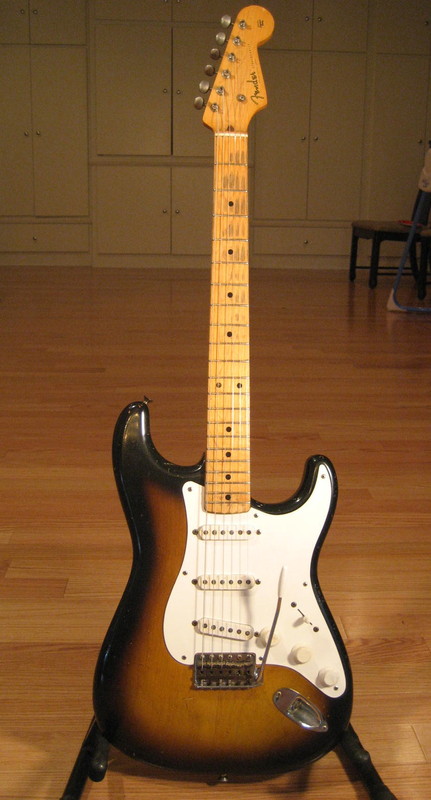
1955 Fender Stratocaster
© vintageguitarz (as of 2011-09-23)
1956
1956 was a year of big changes for the Strat. In the summer, Fender switched the body wood from ash to alder in all sunburst models (blonde finish continued to feature an ash body). The finish process also changed and the yellow tint for the sunburst finish started to be dyed into the wood, as opposed to being sprayed. The thick U-shaped neck was replaced by the soft-V shaped (which seems to be one of the most popular Strat neck shapes these days), the round string tree was replaced by the butterfly-like one and the tuners featured the “Kluson Deluxe” brand engraved on them.
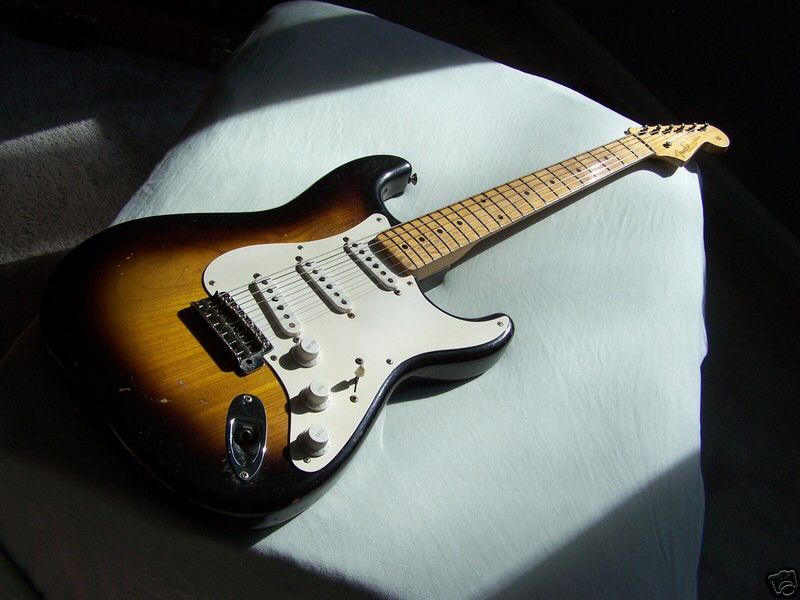
1956 Fender Stratocaster (alder body)
© vintageguitarz (as of 2011-09-23)
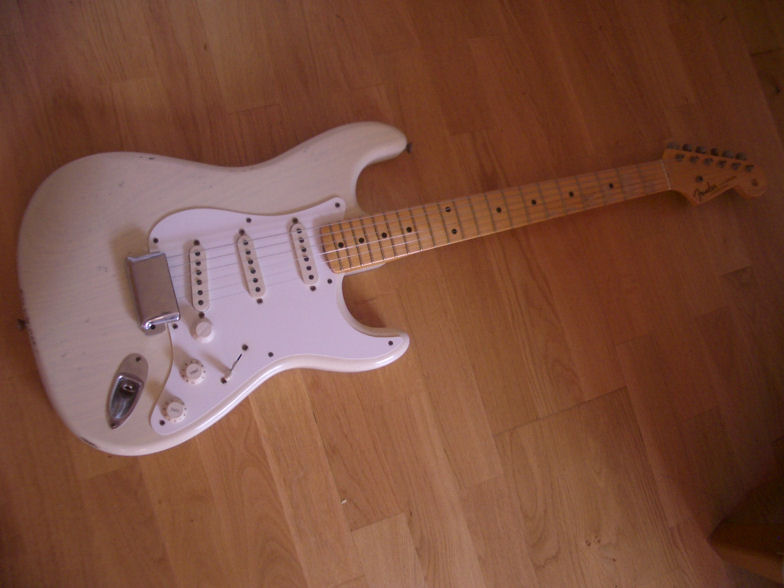
1956 Fender Stratocaster (ash body)
© vintageguitarz (as of 2011-09-23)
1957
The 1957 model is considered to be a classic one. It combines the sunburst finished alder body with a V-shaped neck. Fender also started using ABS plastic instead of polystyrene, which is more resistant and does not crumble like a cracker. This is actually my favorite model to play and one of the reasons I bought the Fender American Vintage ‘57 Stratocaster. It is just wonderful to play and sounds great — you can watch me playing it here. Eric Johnson plays one very often in his tours, as we can see in the G3 – Live In Concert DVD or in this YouTube video.
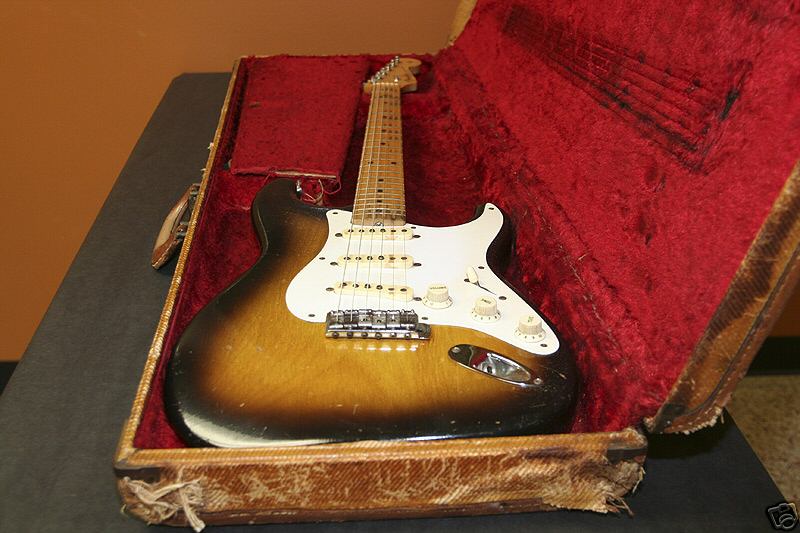
1957 Fender Stratocaster
© vintageguitarz (as of 2011-09-23)
1958-1960
In 1958, the all-time favorite V-shaped neck was gone and the thin U-shaped neck came in. The sunburst finish also changed from two to three colors, which I personally do not like.
1959 also brought some great changes, the biggest of them being the replacement of the maple fingerboard for a Brazilian rosewood one. The plain white pickguard was replaced by a 3-layer celluloid one and the neck got thinner. The 1959/1960 model also had a problem: the red dye in the finish was very reactive to UV light, causing it to fade, so your 3-color sunburst guitar suddenly became a 2-color sunburst, as we can see below.
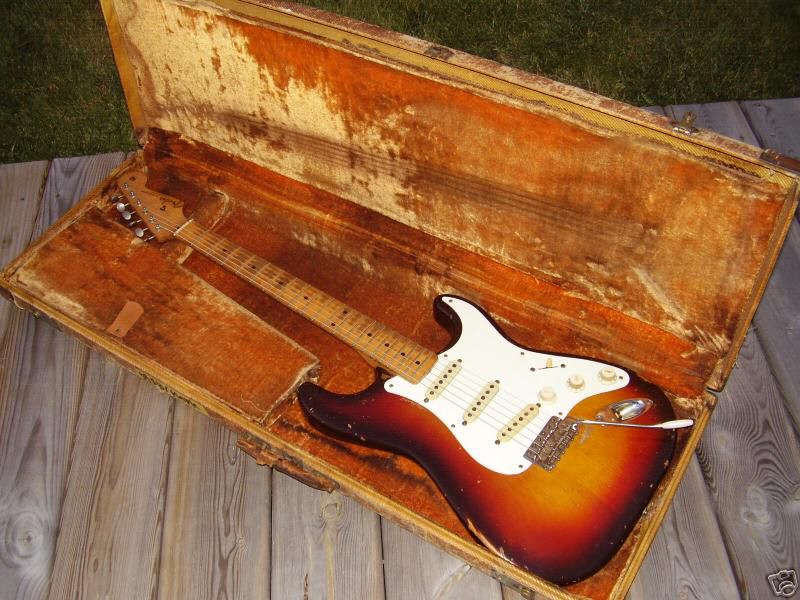
Original 3-color sunburst finish on a 1959 Fender Stratocaster
© vintageguitarz (as of 2011-09-23)
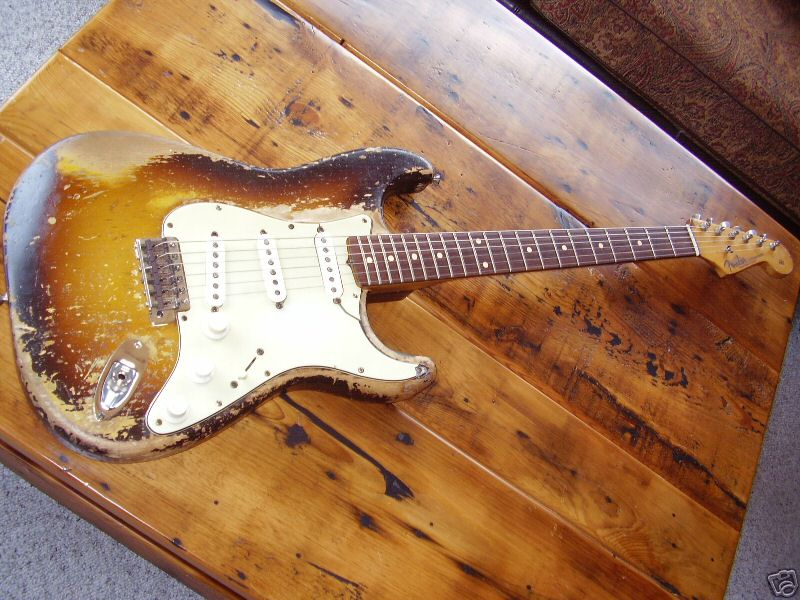
Faded 3-color sunburst finish on a 1959 Fender Stratocaster
© vintageguitarz (as of 2011-09-23)
1961-1962
The fading problem was fixed in 1961, and a darker brown dye was also added to the mix, making it look like another of my favorites — the 1962 model.
The rosewood fingerboard bottom (the part glued to the maple neck) became round, following the board curvature, thus it was thinner, which impacted the sound directly and made it a bit thinner and less bright. Although I prefer the 1950’s tone, I kinda like it as well. In fact, I believe this can be called the first C-shaped neck, which gave birth to the modern Stratocaster neck profile (called modern “C” or flat oval).
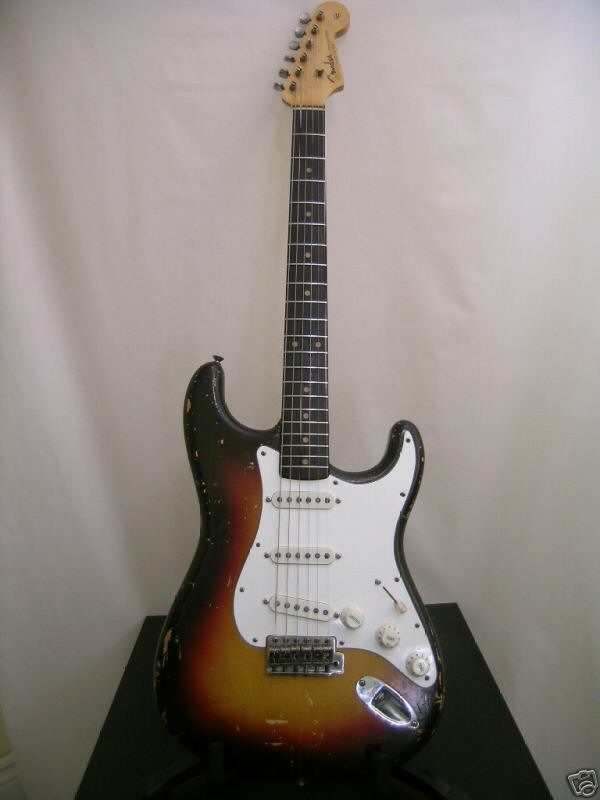
1962 Fender Stratocaster
© vintageguitarz (as of 2011-09-23)
Fender Stratocaster History: transition to CBS
The Strat did not change a lot until mid-1964 and 1965, when the transition to CBS began. And with it, came the road to cheapness. The body finish procedure changed — body dye plus spraying, which allowed Fender to use wood of a less visual quality (the sunburst finish looked specially dull by that time), the clay dots were changed to pearloid (a cheap plastic that looks like pearl) and the celluloid pickguard was replaced by a cheap ABS plastic one. Even the Fender logo became uglier.
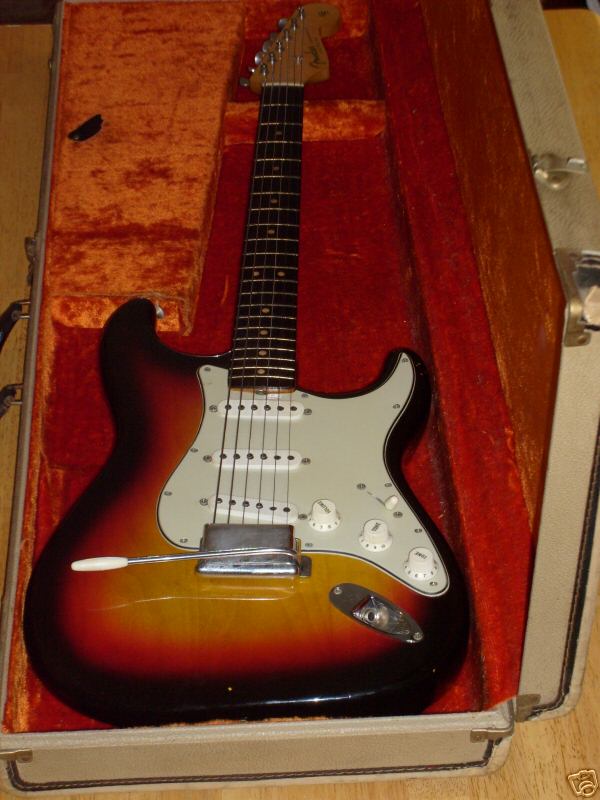
1964 Fender Stratocaster
© vintageguitarz (as of 2011-09-23)
This transition marks the end of the vintage Stratocaster era. All the models from 1954 to 1965 (pre-CBS) are very collectable and can be worth a fortune.
Fender Stratocaster History: CBS era
By January 1965, CBS took control of Fender. And more changes followed. In the end of that year, Fender introduced the large headstock design, which I personally hate.
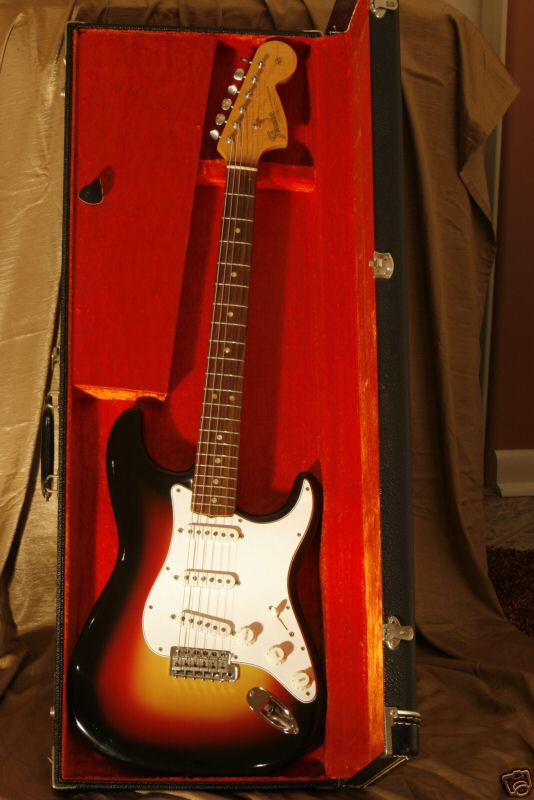
1966 Fender Stratocaster, with the large headstock and old logo
© vintageguitarz (as of 2011-09-23)
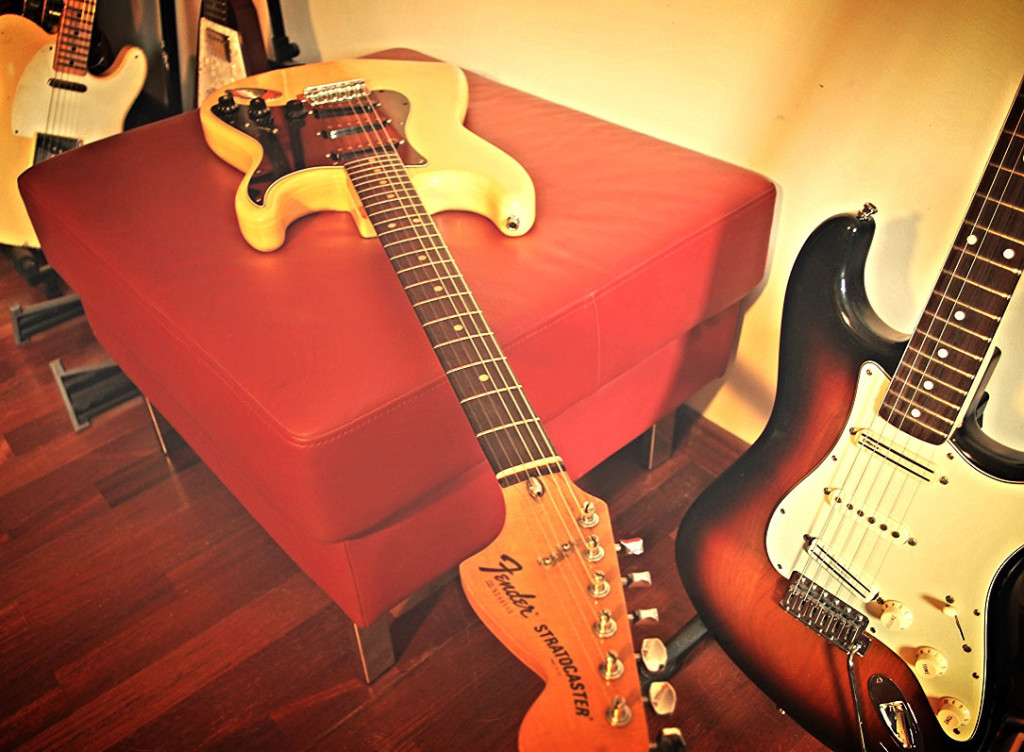
1977 Fender Stratocaster, with the large headstock and new logo, plus the 5-way pickup switch.
© Freebird (as of 2011-09-23)
This design was used until 1980, when I think they realized their big mistake and went back to the small headstock. Another stupid change was the neck joint, which started to be fitted with 3 bolts instead of 4 — this lasted until 1980. In 1977, the 5-way pickup switch was introduced. It is probably the only good change to the Standard model during the CBS era.
Observation: Leo Fender founded Music Man in 1975 after he sold the company to CBS.
Back to the topic, the dark times under CBS lasted until 1985, when the employees of Fender Electric Instrument Manufacturing Company purchased the company from CBS and renamed it as Fender Musical Instruments Corporation, which is the Fender we know today. The company started to build high quality instruments again and started to regain market share and rebuild its reputation.
One important part of the company’s strategy to rebuild was the American Vintage Reissues (replicas of the 1957 and 1962 models), which started in 1982 (when Fender was still under CBS control) and lasted until 1985. Those reissues gave birth to the modern American Vintage Series, which is on sale since 1998.
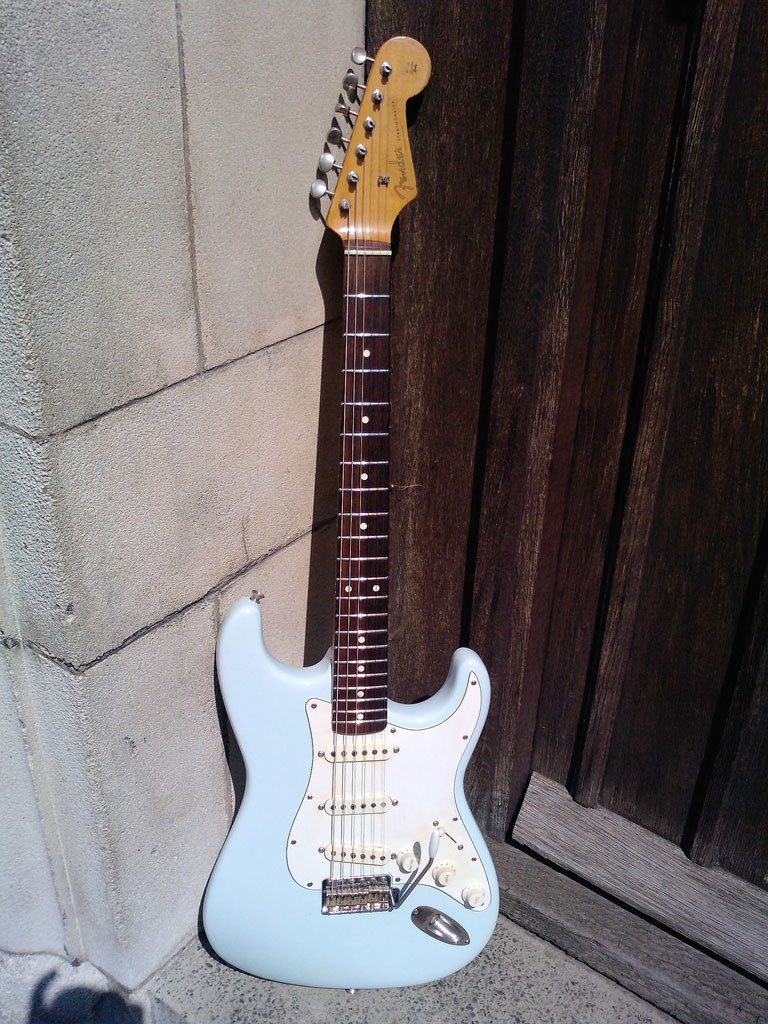
1986 ’62 Fender American Vintage Stratocaster, Made in Japan
© jazgaz (as of 2011-09-23)
Fender Stratocaster History: present
Although Fender today is present in all segments of the market, they still make some high-end Strats with the same quality as the pre-CBS days. And one good thing that happened in the last 30 years is that the Stratocaster range of models grew tremendously, greatly inspired by player modifications, like the humbucker installation in the late 1970s.
Today, the American Standard Stratocaster has the following specs: alder or ash body (usually 2 or 3 pieces of wood) with urethane finish; single-piece maple neck with maple fingerboard or a maple neck with an Indian rosewood fingerboard, both with a modern-C shape profile and 9.25” fretboard radius; 3 single-coil pickups connected to a 5-way switch; deluxe staggered cast/sealed tuners; and a 2-point synchronized tremolo.
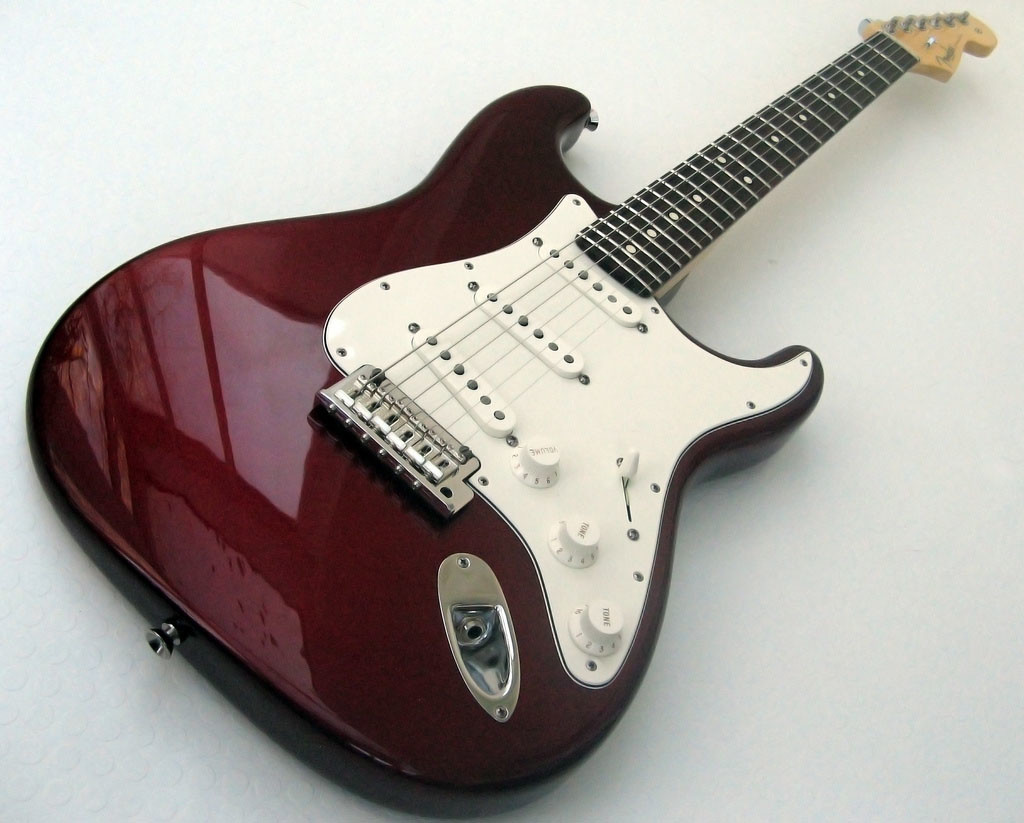
Fender American Standard Stratocaster
© Dylan Beattie (as of 2011-09-23)
To be honest, the modern Strat is a better instrument to play compared to the pre-CBS era. It stays in tune thanks to better tuners and the 2-point tremolo, the modern-C neck is more comfortable to hold, the fingerboard is flatter so that the strings won’t stretch out of the board during a hard bend, the frets are fatter and the guitar is much lightweight. But the tone changed a lot. The alder body/rosewood board combination sounds okay, but the ash body/maple board sounds very thin, bright and rather irritating. The pickups are a bit dull as well.
So, tone-wise the vintage models are better. But that is not much of an issue these days, as the Stratocaster is the easier guitar in the world to modify. And if you do not want to do that, there is probably a model to suit you — vintage reissues, artist signature models, deluxe models and the great and expensive Custom Shop ones.
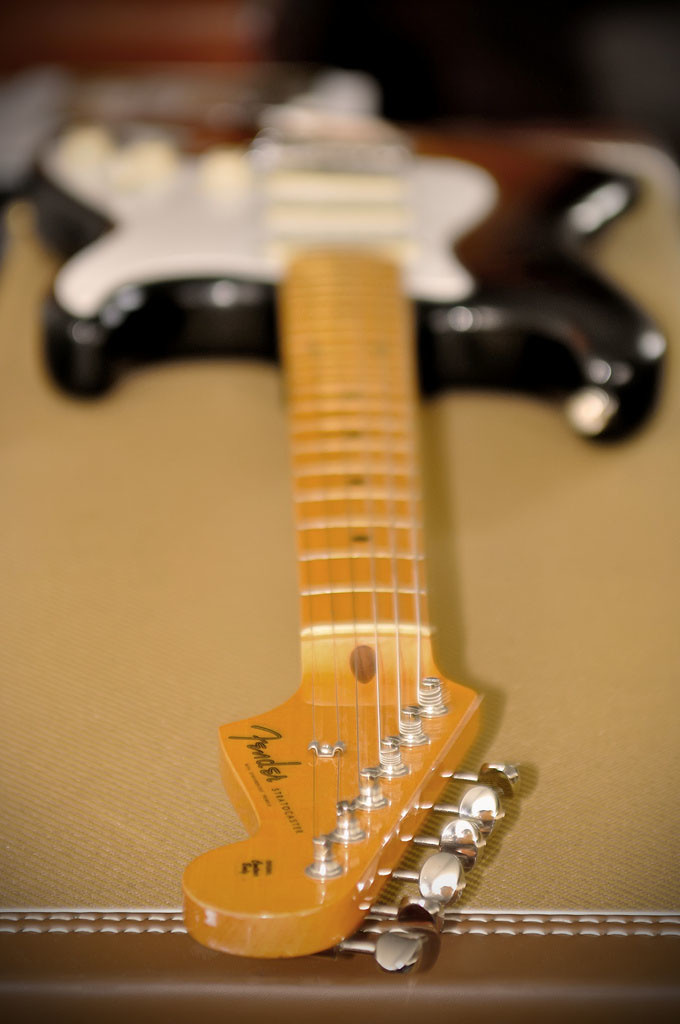
Fender American Vintage ‘57 Stratocaster
To close this article, I will illustrate the Fender Stratocaster history with some of its iconic tones. Enjoy!
- Sweet Home Chicago — Buddy Guy
- Comfortably Numb — David Gilmour
- Layla — Eric Clapton
- Cause We’ve Ended As Lovers — Jeff Beck
- Hey Joe — Jimi Hendrix
- Gravity — John Mayer
- Sultans of Swing — Mark Knopfler
- Lazy — Ritchie Blackmore
- Texas Flood — Stevie Ray Vaughan
- Far Beyond the Sun — Yngwie Malmsteen
* Stratocaster® is a trademark from Fender Musical Instruments Corp.
Hello Carlos:
I very much enjoyed your informative story about the history of the Strat. I would like to offer one piece of history, which you may be able to confirm or deny. I happen to come from the small town of Dos Palos, California, and we are proud to claim former resident Bill Carson, one of the first Fender employees and a terrific guitar player, as the man who created the wood body of the first Stratocaster. He personally delivered a Start to a friend of mine, Ronnie Truhett (whose band won ACM Country Band of the Year honors in 1979) and I had the pleasure of playing once at a High School dance back in 1962 or so. Ronnie told me personally that Bill Carson designed the body. Can you confirm this or not? It’s a proud part of our community story and we would sure like it to be so.
Regards,
Ed Benes
I think it’s hard to pinpoint who designed what in the Strat. What is known is that Leo Fender, Bill Carson, George Fullerton, and Freddie Tavares all played a great role in designing the instrument. Bill Carson in particular, was the guitarist for whom Fender created the Strat.
What I do know is that Carson’s 1959 Fiesta Red Strat had a neck shaped by him, with a 1 7/16″ nut width and a thick rosewood fingerboard.
Thanks for visiting!
Hello Carlos,
Really enjoyed the article. I would say though the 65′ Strat has gotten a bad rep I have owned mine for 42 years (wow! that surprises me) and and have to say it sounds and plays as well if not better then some earlier models I have played. All opinions of course are subjective but I wanted to give a shout out to this vintage having played one now for so long and continue loving to do so.
Thanks again for the article
Tom Lipp
If it suits you well and inspire you to make music, that’s what matters the most. 🙂
Thanks for visiting!
Carlos If the bridge pickup isn’t oriented like in the pictures chances are they are fake or knock offs. The fender strat always had that slight orientation on the bridge pickups or am I wrong?
If it’s a single coil, yes. They have always been angled. Humbuckers are usually parallel to the bridge. I can’t remember any Fender Strat with angled humbuckers.
Last Waltz Stratocaster. http://www.fmicassets.com/Damroot/Zoom/10001/9216112576_gtr_frt_001_rr.png
That’s Robbie Robertson’s customized 1954 Stratocaster. So, not a stock Fender. Interesting thing about that one is that the color was achieved by dipping the guitar body in bronze (the original guitar was red, I think).
The bridge pickup is not a humbucker. If you look closely, it’s a left-handed Strat mid pickup placed right next to the original bridge pickup. There are two pickup height adjustment screws.
After googling a bit about this particular guitar, I found out that Fender Custom Shop made a limited run of replicas in 2016.
The pictured guitar is not Robbie’s customized Strat, but Fender Custom Shop’s Last Waltz Stratocaster.
Hi Carlos,
Can you tell me what year the bridge saddles had “final prospect” on it? Thanks
“Final Prospect” engraving is typically associated with Tokai Stratocasters, not Fender Stratocasters. Tokai Stratocasters had this engraving on the saddles circa 1982.